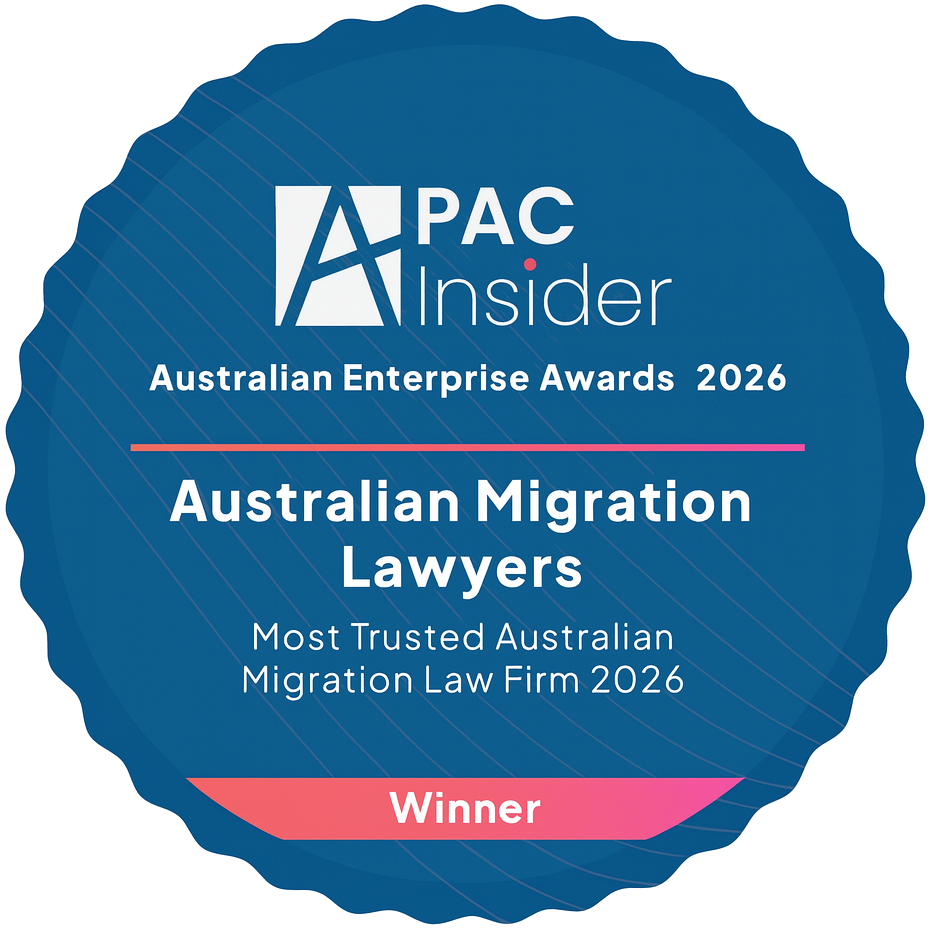Australia's largest independent migration law firm. Open 7 days! Book here.
Need help? We are available 7 days a week.

.webp)

Winner of Most Trusted Australian Migration Law Firm 2023-2026

Ranked 1st for migration law in 2023, 2024 & 2025

Ranked in the top migration lawyers 2023, 2024 & 2025

Ranked the best migration law firm 2024 & 2025
%20(1).webp)
Are you considering applying for an Australian Partner visa and wondering how long the process might take? Understanding the factors that influence these timeframes is a critical first step. In this comprehensive guide, we will go over the key elements that impact the processing of Australian Partner visas, providing you with valuable insights to help you navigate the application journey with confidence.
No matter what stage you are at in your Australian Partner Visa process, the team at Australian Migration Lawyers can help you prepare a complete and robust application to maximise your prospects of a successful outcome. Contact us about your Australian Partner visa application now.
Watch the video below to learn more:
A Partner visa enables Australian citizens, Australian permanent residents or an eligible New Zealand citizen to sponsor their foreign partner to become an Australian permanent resident. As a permanent resident, you can live, work and travel in and out of Australia without restriction. You can also access Medicare and are eligible for domestic fees across Australian education institutions. Permanent residents can also apply for Australian citizenship after two years.
You can apply for a partner visa if you and your sponsoring Australian partner are ‘spouses’ or are in a ‘de facto relationship’. These are terms of art, so they are specifically defined in migration legislation to mean the following:
Some exceptions apply so please contact us to discuss your options if your relationship does not fit within the definitions.
You do not have to be in Australia at the time of application. Those already living in Australia on another temporary visa, can apply for the onshore partner visa (subclass 820, 801) and those living offshore, can apply for an offshore partner visa (subclass 309, 100).
If an applicant and their Australian partner are engaged and the applicant is offshore, they can apply for a Prospective Marriage Visa.
Partner visa applicants can attach their dependent children to their partner visa application. Dependent children will usually be granted a Dependent Child visa while their parent’s permanent visa application is being processed.
Once a partner visa-applicant has been granted permanent residency, they can sponsor dependent children in their own right.
The process of applying for a Partner visa occurs in two stages. The first is the temporary partner visa (subclass 820) or provisional partner visa (subclass 309) stage, and the second is the permanent partner visa stage.
The first stage is significantly more involved than the second stage. During the first stage, applicants must prove to the Department that they are in a genuine and continuing relationship. The Department looks at four key criteria in making its decision:
If the Department is satisfied that an applicant and their sponsoring Australian partner are in a genuine and continuing relationship, they will grant the applicant a ‘temporary’ (subclass 820) or ‘provisional’ (subclass 309) partner visa. This visa allows the applicant to live, work and travel, but the applicant is still considered a temporary visa holder for all intents and purposes. Two years from the date of lodging the application, the temporary partner visa holder becomes eligible to apply for a permanent partner visa – this is stage two.
The second stage requires the temporary partner visa-holder and the sponsor to show the Department that their relationship is continuing. The Department will grant a permanent partner visa (subclass 801 or 100 for onshore and offshore initial applications, respectively) if satisfied.
[free_consultation]
If you are interested in learning more about a Partner visa, contact Australian Migration Lawyers for a consultation.
[/free_consultation]
[table]
[thead]
[tr]
[th]Visa Type[/th]
[th]Eligibility[/th]
[th]Onshore/offshore[/th]
[th]Processing time[/th]
[th]Conditions[/th]
[/tr]
[/thead]
[tbody]
[tr]
[td]Partner visa (Permanent) – subclass 801[/td]
[td]Must hold a temporary partner visa (subclass 820) and be in a genuine relationship [/td]
[td]For onshore applicants [/td]
[td]11-30 months [/td]
[td]Must meet character, health, and relationship requirements [/td]
[/tr]
[tr]
[td]Partner visa (Temporary) – subclass 820 [/td]
[td]Must be in a genuine relationship with an Australian citizen, permanent resident, or eligible New Zealand citizen. [/td]
[td]For onshore applicants [/td]
[td]12-26 months [/td]
[td]Allows the applicant to stay in Australia while processing the permanent partner visa (subclass 801) [/td]
[/tr]
[tr]
[td]Partner (Provisional) visa – subclass 309 [/td]
[td]Must be in a genuine relationship with an Australian citizen, permanent resident, or eligible New Zealand citizen [/td]
[td]For offshore applicants [/td]
[td]13-25 months [/td]
[td]Allows the applicant to stay in Australia while processing the permanent partner visa (subclass 100) [/td]
[/tr]
[tr]
[td]Partner (Migrant) visa -subclass 100 [/td]
[td]Must hold a temporary partner visa (subclass 309) and be in a genuine relationship [/td]
[td]For onshore applicants [/td]
[td]10-20 months [/td]
[td]Must meet character, health, and relationship requirements [/td]
[/tr]
[tr]
[td]Prospective Marriage visa – subclass 300 [/td]
[td]Must be engaged to an Australian citizen, permanent resident, or eligible New Zealand citizen [/td]
[td]For offshore applicants [/td]
[td]12-26 months [/td]
[td]Must marry within 9 months of visa grant and apply for a partner visa (subclass 820) after marriage [/td]
[/tbody]
[/table]
Case officers process partner visa applications at the Department of Home Affairs, which is currently processing thousands of applications. This backlog is the key factor that can impact the processing time of a partner visa application.
Generally, the more complete your application is at the time of lodgement, the shorter the processing time. This reduces the number of times a case officer has to request and review information from the applicant and sponsor.
Typically, permanent partner visa applications process faster than temporary partner visa applications, given the difference in evidentiary requirements between the two.
The processing times of Partner visas differ depending on whether you choose to apply onshore or offshore. The Department of Home Affairs currently estimates that onshore partner visa applications can take anywhere between 15 to 19 months to process, and offshore applications can take between 14 months to 24 months. In our experience, with our support, a comprehensive application can be processed more efficiently.
The Department of Home Affairs is the primary source of official, up-to-date information regarding Australian partner visas. Please refer to the official Department website for the most current processing times.

We have created comprehensive visa guides that outline the ins and outs of visa applications. Get yours today.